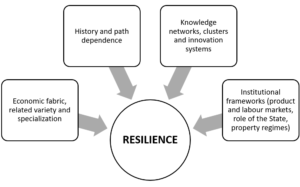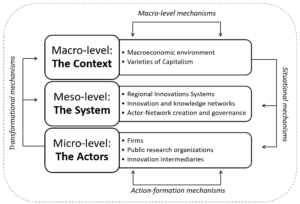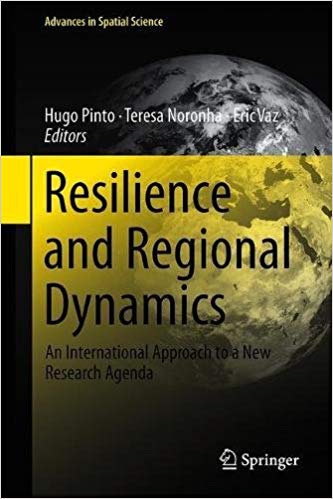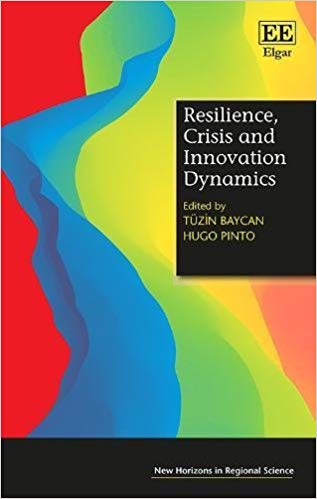Innovation Dynamics and Resilience: A Crucial Agenda for the Future of Regional Studies and Policy

DOI reference: 10.1080/13673882.2018.00001012
By Hugo Pinto, Centre for Social Studies, University of Coimbra, Portugal.
Hugo Pinto develops the concept of the ‘resilience of innovation’, which links ideas about innovation dynamics and resilience to anticipate how regions might respond to external shocks or systemic failures in the economy and environment.
:Introduction:
Complex problems, difficult answers
The world is in a delicate situation. Taking into consideration only the events that made the headlines during the summer of 2018, we now understand how volatile and fragile the environment we are living in is. For example, wildfires have had disastrous consequences from California to Portugal; the oldest and thickest sea ice in the Arctic has started to break up; and a massive floating island of plastics, the Great Pacific Garbage Patch, is expanding at an alarming rate.
A recent study caught the attention of the media (Steffen et al. 2018) suggesting that there is a non-neglectable risk of the Earth entering a “Hothouse Earth” state, in which the climate in the long term will stabilize at a global average of 4-5 degrees Celsius higher than pre-industrial temperatures and a sea level 10-60 metres higher than today. This will happen even if the carbon emission reductions defined in the Paris Agreement are met. A situation that if accurate, clearly raises concerns for our collective future. Reports such as these make evident how crucial it is to accelerate a sustainable transition to an alternative low carbon socio-economic paradigm.
But disruptions go beyond the strict environmental dimension. At the same time the Eurogroup President Mário Centeno is applauding the fact that Greece has now recovered from the 2008 financial crisis (cf. press-release 20 August 2018) and “(…) has regained the control it fought for (…) is now in a position where it can enjoy the full extent of euro area membership, abiding by the same rules as every other euro country”, the alarming unbalancing effects of global economic relations such as these are everywhere. The socioeconomic disruption in Venezuela or the Mediterranean migrant crisis are only two worrying examples of the many that could be highlighted. The fact is that countries across the world have suffered and will continue to suffer in the future from different types of crises, and science has not yet developed the necessary concepts to comprehend these increasingly complex processes of change. However, the idea of resilience has emerged as an interesting candidate that can help shed light on how different systems deal with crises. In particular, it raises new approaches to issues regarding public policy and socioeconomic action.
Resilience has garnered a considerable degree of attention over the last decade. Disruptions in complex socio-economic systems, such as the 2007 financial crisis, have brought attention to this notion in the field of regional studies, as problems, such as the rise of unemployment and the reduction of economic growth, appeared to affect regions in heterogeneous ways and magnitudes. Similarly, innovation dynamics suffered asymmetric effects as a result of the economic slowdown. Countries, regions, public research bodies and firms changed their innovation strategies, but showed different capacities to cope with the crisis, all of which is connected to what can be defined as the ‘resilience of innovation’.
The theory of evolutionary resilience
The concept of resilience refers originally to the stability of materials, its resistance to external shocks, and the capacity of returning to the pre-shock state after suffering the impact. During the 1970s, a period of growing environmental concerns, Crawford Stanley Holling published an influential work in which he applied the concept of resilience to ecosystems, focused on the system’s ability to absorb shocks while retaining its structural functions. Holling understood resilience as a measure of the persistence of systems and their ability to absorb change and disturbance, whilst maintaining relationships between populations or state variables (Holling 1973).
However, it was relatively recently that resilience regained attention. In particular, an evolutionary perspective on resilience has proven popular in regional studies, which attempts to explain how specific territorial systems recover from shocks, not only by returning to previous states, but also by creating new alternatives. The standard version of the literature defines resilience in four forms (Simmie & Martin 2010):
- resistance, which refers to a system’s capacity to keep its structure against external shocks and disturbances;
- recovery, which explains systemic responses after any downward trend;
- re-orientation, an adaptation to new existing orders; and,
- renewal, generation of new pathways.
This vision encompasses three conceptions of resilience: engineering, ecological, and evolutionary. The evolutionary approach to regional resilience focuses on the long-term capacity of regions to deal with shocks (Boschma 2015). It can be said that in an evolutionary framework, resilience is not a mere property or goal, but rather an ongoing process. Resilience should therefore be understood as the adaptive capacity of a socio-economic system to both internal and external change, acknowledging not only that systems are subject to external shocks, but also that a shock may come from internal systemic failures. As such, socio-economic resilience depends on specific aspects: the economic fabric, related variety and specialization; institutional frameworks; history and path dependence; and knowledge networks, clusters and innovation systems (Figure.1).
Figure 1: Determinants of Resilience. Source: Author’s elaboration from Boschma (2015).

Evolutionary resilience admits that often a regional economy cannot return to the state it was before the shock. Additionally, returning to the original state might not even be desirable in certain cases. Thus, a new trajectory must be found, and, preferably, one that could be as efficient or, if possible, even more advantageous than the former. Inspired by this evolutionary perspective, an entirely new area of research on resilience is emerging in regional studies.
What makes a resilient system?
In general, the attributes that make a resilient system are diverse. Nonetheless, some seem to be important in a variety of cases such as diversity, variability, modularity, retroactions, governance redundancy, system services, capital, and innovation (Allan & Bryant 2012).
Diversity is a source of future options. Variability is the acceptance of the added value of difference rather than trying to control or reduce it. Modularity allows the individual units to maintain operation when others fail, permitting that the system as a whole can reorganize itself and adapt. The retroactions refer directly to linkages among the network structures. Institutional architectures should possess a certain threshold of governance redundancy. The system must have services attuned to the functioning of the system itself. A diversity of types of capital augment the capacity of actors to respond accordingly to disturbances. Innovation refers to the emphasis on learning modes, in context-developed rules and acceptance of change.
Innovation is a crucial phenomenon for regional resilience. It is a complex social process involving a wide range densely interconnected actors, from universities and public research organisations to governance bodies and firms, embedded in particular institutional and territorial environments. These environments for innovation are often referred to as innovation systems.
An innovation system is the set of interconnected actors and institutions that affect innovation dynamics. It is a complex adaptive system, consisting of heterogeneous actors, each of which having agency and evolving over time. Furthermore, an innovation system is also characterized by having several sub-systems within it. The first generation of studies, based in a systemic approach to innovation, placed great emphasis on National Innovation Systems (NIS) of developed countries, their institutional structures, collective learning and path dependencies. The second generation of innovation system studies were more sceptical, towards the macro-approach of NIS and evidenced a shift towards a regional perspective, which was related to the importance given to geographical proximity for innovative activities. The Regional Innovation System (RIS) concept was a particularly influential idea in European Union regional policy-making, as can be confirmed in the RIS3 (Research and Innovation Strategies for Smart Specialisation). I propose that the existence of well performing regional innovation systems is a prerequisite for the development of resilient regions.
Developing a multi-level framework for innovation and resilience
Considering that two of the main difficulties in the study of resilience are the choice of the system under analysis and how to connect resilience at one particular scale with the resilience of the individual actors that compose the system and its own specific resilience characteristics, the utilisation of the RIS concept can be beneficial to the understanding of resilience mechanisms between macro and micro-levels.
The multi-level perspective (MLP) (Geels 2010) can provide a good approximation to a complex subject such as the ‘resilience of innovation’. The MLP is structured around three levels of analysis: the context, the system and the niche.
The context, also called the socio-technical landscape, characterizes the macro level, which influences the levels below. The context highlights not only the technical and material scenario that sustains society, but also includes demographic trends, political ideologies, social values and macroeconomic patterns that characterize certain varieties of capitalism. The varied sets of factors are combined and form the external environment that the actors cannot influence directly in the short term. In general, the context changes slowly.
The system, often called regime in the MLP literature, is the deep structure which explains stability. It refers to the set of semi-coherent rules that guide and coordinate activities of social groups that reproduce the various elements of socio-technical systems. These rules are both means and outcomes of the action. The existing arrangements are characterized by lock-in processes by which innovation usually happens incrementally, with minor adaptations accumulating stable trajectories. These trajectories occur not only in technology but also in cultural, political, scientific, and industrial markets. The concept of system intends to capture the meta-coordination between different sub-systems. The alignment between sub-systems can provide additional stability, but it can also lead to stress. The system tries to emphasize the idea of stability but can also be a destabilizing force targeted to the upper level, the context, or to the new socio-technical configurations below, the niches.
The niche refers to the micro level. Niches are protected areas such as R&D laboratories, demonstration projects, or specific innovative firms, where users have special requirements and are willing to support emerging innovations. Niche actors work in innovation that deviates from the existing status in the system.
The majority of research pays attention to only one of the analytical levels. However, if we accept that innovation actors largely depend on existing macro-structures we then need to understand the importance of collective dynamics. We also need to accept that context and innovation systems depend on individual agency and therefore we cannot completely reject the relevance of individual action to institutional change.
Figure 2: The Multi-Level Approach to the Resilience of Innovation. Source: Own elaboration

Mechanisms help us to understand the interaction between different levels in the creation of resilience. A mechanism regards a path or process in which an effect is produced, or a purpose is achieved. One commonly used typology (Hedstrom & Swedberg 1996) shows that mechanisms can be macro-causal involving only macro-level processes in a horizontal form, for example relating two institutional dimensions. Situational mechanisms have a descendant nature, are based on the structural conditions and institutional architectures to restrict and empower system properties and individual action. The action-formation mechanisms refer to the horizontal influence of certain actors in changing the behaviour of other individual actors. The transformational mechanisms are upward effects that show the influence of actors and systems in larger institutional processes. Mechanisms allow us to understand institutional change and the behaviour of actors, they are also critical for the evolution of the system shaping the selection, variation and reproduction of routines.
Figure.2 provides a summary of the interrelation of these three levels, the specific approaches to understand each one, and the mechanisms to highlight relevant multi-level interactions.
Setting an agenda for resilience systems
Resilience is an evolutionary and non-equilibrium characteristic based on innovation as the way to explore opportunities for new paths. It is important to emphasise that the idea of complex adaptive systems is central, by permitting the consideration of interactions among different scales and the generation of emergent properties of the systems. Resilience operates at different levels, and it is especially relevant to understand how these different levels interact with each other, and how new properties emerge in systems.
The ‘resilience of innovation’ can be understood as the capacity at different levels, from the system to the individual actor, to maintain or create innovation trajectories when facing external shocks or systemic failures. The definition of a new, more complete framework that combines the concepts of resilience and innovation, would be a significant achievement for regional studies.
Innovation is crucial to create adequate answers for the societal challenges that we are confronted with now. More and better research on how innovation process can stimulate regional resilience is welcome to help policy-makers develop actions to increase the capacity of the territories to resist and adapt to disruptions that are becoming ever more commonplace in our volatile world. This is likely to become a priority for national and regional authorities dealing with development and risk management strategies.
My recent books “Resilience and Regional Dynamics: An International Approach to a New Research Agenda” co-edited with Teresa Noronha and Eric Vaz, and “Resilience, Crisis and Innovation Dynamics” co-edited with Tüzin Baycan tried to discuss how innovation may help to configure resilient regions, providing a variety of theoretical contributions and case studies. Both books present a robust discussion about the myriad of connections between innovation dynamics and resilience. Hopefully, they will provide much for scholars in this field to consider and sound a signal for the urgent change that is needed to meet the current crises facing the world.
Acknowledgements
Hugo Pinto acknowledges the financial support from FCT – Fundação para a Ciência e a Tecnologia (project “Resilience of Innovation Systems under Economic Turbulence” SFRH/BPD/84038/2012) funded by POPH – NSRF – Type 4.1 – Advanced Training, co-funded by the European Social Fund and the Portuguese Ministry of Science, Technology and Higher Education.
References
Allan, P. & Bryant, M., 2012. Resilience as a framework for urbanism and recovery. Journal of Landscape Architecture, 6(2), pp.37–41.
Boschma, R., 2015. Towards an evolutionary perspective on regional resilience. Regional Studies, 49(5), pp.733–751.
Geels, F.W., 2010. Ontologies, socio-technical transitions (to sustainability), and the multi-level perspective. Research Policy, 39(4), pp.495–510.
Hedstrom, P. & Swedberg, R., 1996. Social Mechanisms. Acta Sociologica, 39(3), pp.281–308.
Holling, C.S., 1973. Resilience and Stability of Ecological Systems. Annual Review of Ecology and Systematics, 4(1), pp.1–23.
Simmie, J. & Martin, R.L., 2010. The economic resilience of regions: towards an evolutionary approach. Cambridge Journal of Regions, Economy and Society, 3, pp.27–43.
Steffen, W. et al., 2018. Trajectories of the Earth System in the Anthropocene. Proceedings of the National Academy of Sciences of the United States of America, 115(33), pp.8252–8259.
About Hugo Pinto

Hugo Pinto hpinto@ces.uc.pt is a Researcher at the Centre for Social Studies, University of Coimbra and Assistant Professor at the Faculty of Economics, University of Algarve (Portugal). His research interests are regional development, innovation systems, knowledge transfer, and smart specialisation.

